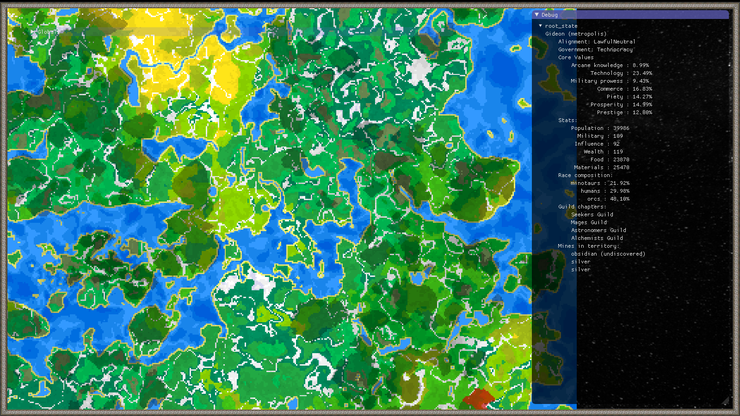What makes a city-state
Figure 1 Above, the territory of a selected city is highlighted with red (bottom left), while all other territories have a darker shade. On the right, city-state information is displayed.
Now that territories have been defined, we need to flesh out the city-states a bit more. The city-states will act as adventuring hubs, source for quests, target of other quests, and will also have a gameplay mind of their own. So, what makes a city-state?
Races
Each city has a race composition (out of about 10 currently), defined as percentages. The racial variety will depend on the level of the city. A small village will be composed of a single race, while a buzzing metropolis could have more than 5 races.
Alignment
Cities use the DnD alignment axes ( Lawful/Neutral/Chaotic and Good/Neutral/Evil) to represent what they stand for, and their goals. A chaotic neutral character would obviously prefer a similarly aligned city, as the interests would better match.
Statistics
Cities have 4 main statistics: Population, Influence, Wealth and Military. Influence directly affects the city-state territory, and the rest are self-explanatory. They will have gameplay effects, but not quite fleshed out yet.
Resources
Cities have food and basic material reserves. These resources depend on the biome tiles within a city's territory. Rare resources (silver, gold, crystals and more) can also exist in a city's territory, and they need to be mined to provide the prestigious resources. Such mines can be the target of sabotage, or places where disastrous events take place, and so on.
Core Values
Each city has a "score" (more like a weighted percentage) for each of several "core values". These are Arcane Knowledge, Military Prowess, Prestige, Piety, Commerce, Prosperity and Technology. The score in each of these values would represent the strategies and interests of the city-state. E.g. a city-state interested in Arcane Knowledge would be looking for magical relics, while a Commerce-oriented one would be more interesting in setting up a complex trade network. Military city-states would be launching attacks on other city-states that they hate, or against any other invaders. In terms of future implementation, when trying to choose between behaviors classified with these core values, the weighting would affect the choices.
Guild chapters
In the game there will be several guilds, and each guild can have chapters in different cities.
Guilds can be of "class", "lore" and "trade" type. Class guilds are fighters guild, clerics guild, rangers guild etc, so that the members can be adventuring classes. Lore guilds are explorers guild, historians guild, seekers guild, etc, that are interested in uncovering information about the world and long-forgotten relics. Trade guilds are blacksmiths, jewelers, alchemists etc, who unionize and typically sell things or services. Everybody gives quests, but PCs will possibly not be able to join trade guilds, as a player you don't want to be in the shop all day serving customers, or reading books to do research.
Guilds have alignment, so that a chaotic evil guild will not exist in a good-aligned city (unless they're operating secretly).
Guilds can have biome requirements, for example a pirates' coven will only exist at a coastal city, or a druid enclave would exist only in a village or a town, near woods.
Some guilds are secret, for example a pirates' guild, a necromancers' guild, an assassins' guild etc. To find those, certain conditions need to be met.
Guilds give quests, some might have initiation quests, and there will be quests (and rewards) for advancing in rank.
Some guilds might not like some other guilds. Due to them being competitors or have very different values. This would be reflected on how guild members treat each other.
Relations
City-states optionally have relations with other city-states. Generally, the closer a city-state is to another, the more likely the relationship to be more polarized (love or hate), compared to city-states that are very far from each other. The reasoning behind this is of course friction and interaction due to proximity. Additionally, like-mindedness in terms of alignment and core values would affect the relations, as a chaotic good city-state could never be friendly to a lawful evil one.
So that's it for now, next time it's going to be more on relations and also routes between cities and mines.
Figure 2 Another city-state territory and information, similar to Figure 1


